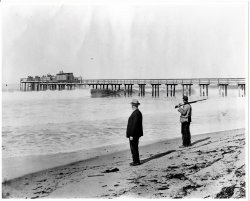Apparently San Diego authorities have wondered if wave machines of some type could be installed on the new Ocean Beach Pier to generate electricity. My advice — no.
#1 - Example — Imperial Beach
http://www.ci.imperial-beach.ca.us/index.asp?Type=B_BASIC&SEC={A1F91FC5-FCA6-4719-BFA1-9CC891BA68CD}
The City of Imperial Beach — The "modern" history of Imperial Beach started about June 1887 when R. R. Morrison a real estate developer, filed a subdivision map with the San Diego County Clerk. The map referred to the area as South San Diego Beach, The area It encompassed was 5th Street to 13th Street north of Palm Avenue and from about 9th Street to 17th Street between Palm Avenue and (what today is) Imperial Beach Blvd. This included areas that have since been annexed by San Diego and which were formerly called Palm City. Mr. George Chaffey purchased several plots of land for subdivision. His intent was to create a summer retreat for the people of Imperial Valley. It's considered that the name 'Imperial Beach" was coined as part of a marketing strategy. Mr. Frank J. Cullen, another sub-divider, did some building on 1st street. Some of his structures lasted until 1963 when they were razed to provide space for the Municipal Pier parking lot.
The 1880's came to be known as the land boom era, Promoters followed the same general pattern. First came acquisition and subdivision which was followed by a hotel or other attraction. Then came the land auction and finally the hardest part, the building of the community by its residents. In the years preceding and following, this same general pattern held true for many of the developments in the surrounding area, such as Coronado Heights, Oneonta, Monument City, South San Diego, International City, Barbers Station, South Coronado, Tia Juana City and San Ysidro. Imperial Beach got its first sidewalks in 1909-1910. The Disinger's operated a general store, post office and a branch of the county library on First Street for nearly fifty years. Down the street a few blocks, Mrs. Harmon built a d
ance pavilion with an adjoining cafe. It reached its peak of popularity during World War I and operated until it burned down on Christmas Day, 1943, when its cooking tanks exploded. The roof on the home of Harold and Genevieve Ord caught fire from drifting cinders. Ord was away from home, fighting the Cafe-Pavilion fire.
A pier was constructed about 1909. Its original purpose was to generate electricity for the town using wave action which activated massive machinery on the end of the pier. It worked inadequately for its intended purpose and the "Edwards Wave Motor," as it was named, was disassembled and removed. For many years the pier attracted large crowds as did the nearby boardwalk and bathhouse. The wooden pier finally deteriorated and it washed to sea in a severe 1948 storm. The boardwalk lasted until 1953.

#1 - Example — Imperial Beach
http://www.ci.imperial-beach.ca.us/index.asp?Type=B_BASIC&SEC={A1F91FC5-FCA6-4719-BFA1-9CC891BA68CD}
The City of Imperial Beach — The "modern" history of Imperial Beach started about June 1887 when R. R. Morrison a real estate developer, filed a subdivision map with the San Diego County Clerk. The map referred to the area as South San Diego Beach, The area It encompassed was 5th Street to 13th Street north of Palm Avenue and from about 9th Street to 17th Street between Palm Avenue and (what today is) Imperial Beach Blvd. This included areas that have since been annexed by San Diego and which were formerly called Palm City. Mr. George Chaffey purchased several plots of land for subdivision. His intent was to create a summer retreat for the people of Imperial Valley. It's considered that the name 'Imperial Beach" was coined as part of a marketing strategy. Mr. Frank J. Cullen, another sub-divider, did some building on 1st street. Some of his structures lasted until 1963 when they were razed to provide space for the Municipal Pier parking lot.
The 1880's came to be known as the land boom era, Promoters followed the same general pattern. First came acquisition and subdivision which was followed by a hotel or other attraction. Then came the land auction and finally the hardest part, the building of the community by its residents. In the years preceding and following, this same general pattern held true for many of the developments in the surrounding area, such as Coronado Heights, Oneonta, Monument City, South San Diego, International City, Barbers Station, South Coronado, Tia Juana City and San Ysidro. Imperial Beach got its first sidewalks in 1909-1910. The Disinger's operated a general store, post office and a branch of the county library on First Street for nearly fifty years. Down the street a few blocks, Mrs. Harmon built a d
ance pavilion with an adjoining cafe. It reached its peak of popularity during World War I and operated until it burned down on Christmas Day, 1943, when its cooking tanks exploded. The roof on the home of Harold and Genevieve Ord caught fire from drifting cinders. Ord was away from home, fighting the Cafe-Pavilion fire.
A pier was constructed about 1909. Its original purpose was to generate electricity for the town using wave action which activated massive machinery on the end of the pier. It worked inadequately for its intended purpose and the "Edwards Wave Motor," as it was named, was disassembled and removed. For many years the pier attracted large crowds as did the nearby boardwalk and bathhouse. The wooden pier finally deteriorated and it washed to sea in a severe 1948 storm. The boardwalk lasted until 1953.

Last edited:
